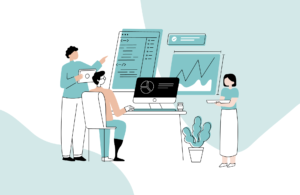In today’s data-driven world, the ability to effectively communicate information through data visualization has become increasingly important. Whether you’re presenting findings to a team, creating reports for stakeholders, or simply trying to make sense of complex data yourself, choosing the right design for data visualization is crucial. The right design not only enhances the understanding of the data but also engages the audience and drives impactful insights. Here are some key considerations to keep in mind when selecting the appropriate design for your data visualization.
Understand Your Data and Goals
Before diving into design choices, it’s essential to have a clear understanding of your data and the goals of your visualization. Start by examining the type of data you’re working with. Is it quantitative or qualitative? Is it categorical or continuous? Understanding the nature of your data will help determine the appropriate visualization techniques.
Next, identify the goals of your visualization. Are you trying to compare trends, highlight patterns, or showcase relationships? Knowing your objectives will guide you in selecting the right visual elements and interactions that align with your goals.
Know Your Audience
Consider who will be viewing your data visualization. Different audiences have varying levels of familiarity with data and may respond better to specific design choices. Are you presenting to executives, data analysts, or the general public? Tailor your design to cater to their preferences and level of expertise. Strive for a balance between simplicity and complexity, ensuring that your visualization is both accessible and informative.
Choose the Right Visualization Type
There is a wide range of visualization types available, including bar charts, line charts, scatter plots, heat maps, and more. Each type has its strengths and weaknesses, so it’s important to choose one that best represents your data and goals. Consider the following factors when selecting a visualization type:
- Data Relationships: Determine the relationships you want to illustrate, such as comparisons, distributions, or hierarchies. For example, a bar chart is suitable for comparing data across different categories, while a scatter plot is effective for showcasing relationships between two variables.
- Data Attributes: Consider the attributes you want to display, such as quantities, proportions, or spatial data. If you’re working with temporal data, a line graph or a time series visualization might be appropriate.
- Data Complexity: Assess the complexity of your data. If you have a large dataset, a hierarchical or tree-based visualization might be helpful in displaying the structure and relationships.
Emphasize Clarity and Simplicity
The primary purpose of data visualization is to communicate information clearly and concisely. Avoid cluttering your visualizations with excessive elements that can confuse or distract the audience. Keep the design clean and uncluttered, focusing on the most important data points. Use appropriate labels, titles, and legends to provide context and aid comprehension. Color choices should be deliberate and consistent, enhancing the understanding of the data rather than adding unnecessary complexity.
Consider Interactivity
Interactive features can enhance engagement and exploration of data visualizations. Depending on the medium you’re using, consider incorporating interactive elements such as tooltips, filters, or zooming capabilities. Interactivity allows users to delve deeper into the data, explore different dimensions, and discover insights that may not be immediately apparent in static visualizations. However, ensure that the interactive elements are intuitive and serve a purpose rather than overwhelming the viewer.
Test and Iterate
Designing effective data visualizations is an iterative process. Once you have created your initial visualization, seek feedback from users or colleagues. Test the visualization with a small group of representative users and gather their input on clarity, comprehension, and overall effectiveness. Iterate on your design based on the feedback received, making adjustments to improve its impact and understanding.
Conclusion
In conclusion, choosing the right design for data visualization is a critical step in effectively communicating your data. By understanding your data, considering your audience, selecting appropriate visualization types, emphasizing clarity, incorporating interactivity, and iterating on your designs, you can create visualizations that inform, engage, and drive meaningful insights. Remember, the ultimate goal is to empower your audience to gain valuable knowledge and make informed decisions from the data you present.
Once the design is finalized, the next step is to implement it using the right visualization tool.



